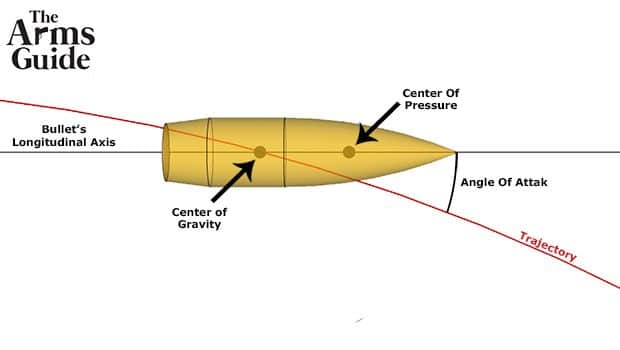As you likely already know, bullets spin during flight, due to the rifling of the barrel. But, you may have asked yourself: why do they need to spin? The answer has something to do with bullet shape.
In this article, I’ll show you the reason behind bullet spin with regard to bullet shape. Understanding this concept is useful to understand other bullet flight behavior that I’ll introduce in the future. Understanding how bullet shape affects its stability in flight is also useful in the process of selecting the right ammo, or the right bullet, for your rifle.
Bullets designed for long distances have all been engineered to fight against drag, so that they have a flatter and longer trajectory. For hunting and military purposes, bullets are also designed to maintain enough velocity, and therefore enough energy, to neutralize targets at long distances. These are the components of a standard long range bullet’s shape:
The cylindrical portion, which is the part that is forced into the barrel and is cut by the rifling.
The nose: Ogive shaped, and specifically designed to pierce through the air, fighting against drag.
The tail: In bullets designed for long range, the common shape is called boat-tail (tapered toward the end), and it is designed to reduce the turbulence behind the bullet and reduce drag.
On the bullet, we can identify two points:
The center of mass, that is, the point where the bullet balances its weight. When in fight, the center of mass is the only point of the bullet that actually follows the trajectory.
The center of pressure, that is, the point where the aerodynamics force, in this case the drag of the air flow (and a little bit of lift), act on the bullet.
As soon as it exits the barrel, the bullet starts its descending trajectory. As we have seen before, only the center of mass follows the trajectory. The tip of the bullet doesn’t follow the trajectory. In other words, the bullet axis is not pointed in the same direction as the axis of movement. In fact, the bullet longitudinal axis tends to remain pointed in the direction of the line of departure. Therefore, because of the bullet shape, the projectile will always fly at an angle, called angle of attack, relative to the trajectory. The result will be that the air flow will not push on the center of pressure from the front, but at an angle from below. Since the point of pressure is positioned in front of the center of mass, the air flow will force the bullet to rotate backward, pivoting on its center of mass.
In addition, due to its particular shape, the bullet has its center of mass behind its center of pressure. When the bullet is in flight, the center of pressure always positions itself in the direction of flight, that is, with the tail pointed forward, pivoting on the point of pressure.
If the bullet is not stabilized, these two forces acting together will cause the bullet to tumble. We can consider the distance between the center of mass and the center of pressure as a lever. The longer the “lever” is, the higher the destabilizing force it causes. Longer bullets, and especially bullet shaped with long ogives, have longer “levers” and thus are the most unstable.
In the next article, I’ll show you how the spinning motion, generated by the barrel’s rifling, keeps the bullet stable. Also I’ll talk about how to predict if a particular bullet can be stabilized by a particular twist rate, since this is important in the selection of the best bullet (or the best ammo) for our rifle.


